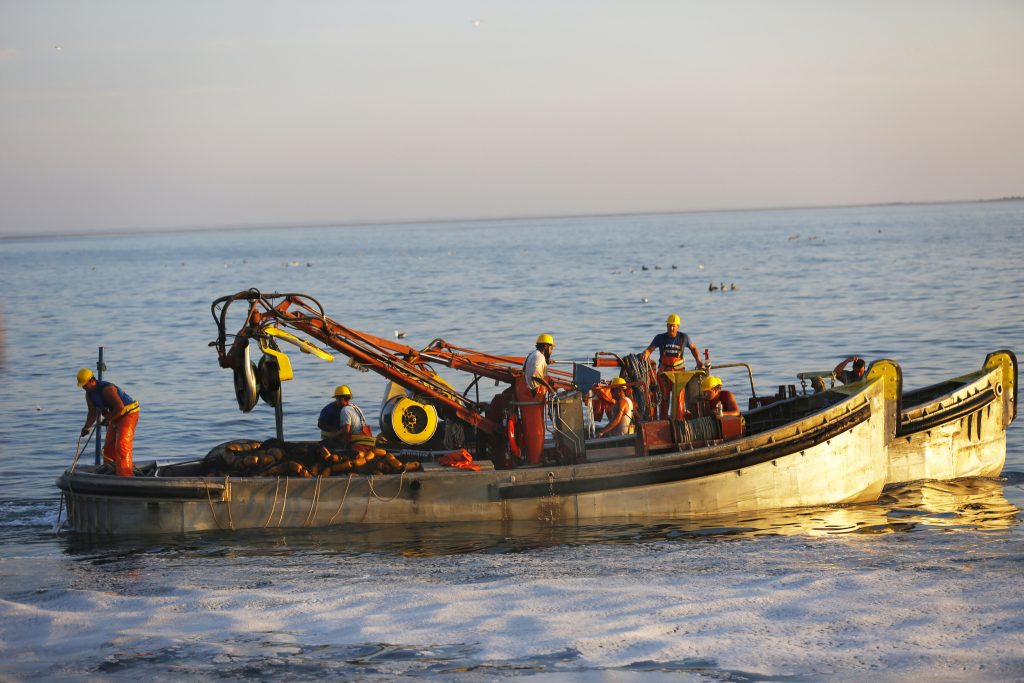AFL-CIO, United Food & Commercial Workers, Chamber of Commerce, Manufacturers Association, Seafood Council, and Watermen Urge Virginia to Reject Commission Decision
February 7, 2018 (Saving Seafood) – WASHINGTON – Virginia business and labor groups have united in calling on Virginia’s General Assembly to reject a reduction in the state’s menhaden quota. In a letter to the Chairmen of Virginia’s Senate and House committees on Agriculture and Natural Resources, the groups argued that the Atlantic States Marine Fisheries Commission’s (ASMFC) decision to redistribute a share of Virginia’s menhaden allocation to other states is unfair and damaging to Virginia businesses and workers.
 The letter, sent yesterday to Chairman Richard Stuart of the Virginia Senate Agriculture, Conservation and Natural Resources Committee and Chairman Danny Marshall of theVirginia House Agriculture, Chesapeake and Natural Resources Committee was signed by the Virginia AFL-CIO, the Virginia Chamber of Commerce, the Virginia Manufacturers Association, the Virginia Seafood Council, the Virginia Waterman’s Association, and the United Food and Commercial Workers Local 400.
The letter, sent yesterday to Chairman Richard Stuart of the Virginia Senate Agriculture, Conservation and Natural Resources Committee and Chairman Danny Marshall of theVirginia House Agriculture, Chesapeake and Natural Resources Committee was signed by the Virginia AFL-CIO, the Virginia Chamber of Commerce, the Virginia Manufacturers Association, the Virginia Seafood Council, the Virginia Waterman’s Association, and the United Food and Commercial Workers Local 400.
In November, the ASMFC voted to raise the coastwide allocation of Atlantic menhaden by 8 percent but redistributed it in such a way that the two largest menhaden producing states – Virginia and New Jersey – saw their percentage of the coastwide catch reduced. Under Virginia law, the state legislature must pass legislation accepting the decision of the ASMFC before any such determination becomes effective in the Commonwealth.
“The ASMFC re-allocated the number of menhaden each state could land, giving increased shares to states with little to no menhaden fishing activity,” the groups wrote. “This plan unfairly takes from Virginia while increasing the total allowable catch on the Atlantic Coast by 16,000 metric tons.”
In their letter, the groups argued that the ASMFC could have avoided this problem by increasing the quota further; they pointed out that scientists on the Commission’s Menhaden Technical Committee previously concluded that the coastwide quota could be increased by over 40 percent without a risk of overfishing.
Virginia’s General Assembly is currently considering legislation that would accept the ASMFC’s quota and reallocation plan. The letter calls on legislators to vote against the pending bill.
“Should Virginia reject this, they will stand up for all fisheries managed by the ASMFC,” the groups wrote in their letter. “Should Virginia accede to the ASMFC on this issue, in the future other states may team up on Virginia, take our allocation of other fish, and distribute it to other states.”
The request from organized labor and business groups comes at a delicate time for the ASMFC. As their letter notes, there is recent new precedent for a state that believes its own rules provide adequate conservation to successfully appeal a decision made by the ASMFC. Last June, the Commission recommended to Secretary of Commerce Wilbur Ross that New Jersey be found out of compliance with new rules on recreational summer flounder fishing, known as Addendum XXVIII. However, Secretary Ross did not agree with the Commission’s determination, and ruled New Jersey to be in compliance, marking the first time the Commerce Department had rejected a noncompliance recommendation from the ASMFC.
In a letter to ASMFC Executive Director Robert Beal, Assistant Administrator for NOAA Fisheries Chris Oliver wrote, “New Jersey makes a compelling argument that the measures it implemented this year…will likely reduce total summer flounder mortality in New Jersey waters to a level consistent with the overall conservation objective…” As a result, “the Secretary has found that the measures are likely to be equivalent in total conservation as those required under Addendum XXVIII,” Administrator Oliver wrote.
According to the ASMFC, the menhaden fishery is sustainable and the stock remains healthy. The Commission’s most recent stock assessment, completed in 2017, concluded that menhaden is currently not overfished and is not experiencing overfishing.
